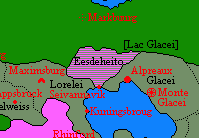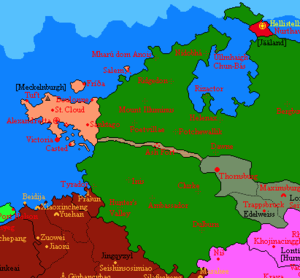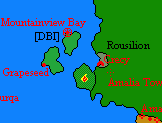Military Operations of Lac Glacei
Operation Underlord

In keeping with Lac Glacei's objective to combat piracy in the Strait of Pearls, the Grand Duke ordered the launch of Operation Underlord, which resolved to bring the former isles of Norsmandy under control of the Grand Duchy, which would then be utilized as a forward operating base to extend naval patrols along the strait. Elements of the Glaceian Army Reserve Department were deployed from Ergo Sum and the Tigra Isles. The operation was split into two phases:
- Phase I: The LS Chang was deployed with the LS Rosario as escort to lead an amphibious assault on Bajoccas, the largest of the three Norsman isles. The carrier Konigen was deployed as a rear guard and to provide air-to-ground support. Lac Glaceian marines would lead a spearhead assault onto Bajoccas where they would take control of the island and secure the area for more troops to be brought in. Once Bajoccas is secure, the other two islands could then be taken.
- Phase II: Aircraft from the Konigen will provide ongoing air-to-ground support by strafing enemy positions on the islands. The Lac Glaceian Mala-class helicopter will be on hand to provide additional air-to-ground support.
Operation Underlord was officially declared on 7.1695 AN and immediately commenced engagement. The barbaric tribes of Norsmandy were caught completely off guard as marines landed in the early hours of dawn on the southern shores of Bajoccas. Air forces were able to disable the defenses of two coastal villages, allowing amphibious forces a clear window to enter and secure the area. The local population was armed mostly with hunting rifles and had few prepared defenses capable of withstanding the assault. Within three hours the southern half of Bajoccas was secure and more troops were being ferried in from Fort Matthias. Once fighting entered the central area of the island, troops were forced to slow their progression, as by this time the rest of the island had been alerted to the attack. It took twenty-eight more hours for the remainder of Bajoccas to be secured, with total casualties amounting to 18 Lac Glaceian soldiers and 73 Norsmen. By the next morning a temporary prison camp had been established to hold and process POWs and a operational HQ constructed in the south.
The third day of the conflict saw the expansion of the assault with new attacks on the other two Norsman isles; Jarnia and Magus. Jarnia, the northernmost of the three Norsman isles, had a negligible population of around seventy inhabitants, and was secured quickly and without much conflict and, thankfully, without any casualties. Magus had a more sizable population of around eight-hundred and forced another amphibious landing by Lac Glacei's marines. While only a fraction of the size of Bajoccas, the operation followed a similar routine. Air support only required the assistance of the Mala-class helicopter, and the island was secured within fifteen hours. No losses were incurred by GARD forces, with ten local casualties.
By the fourth day of the conflict the entirety of Norsmandy was under Lac Glaceian control and the government began an active program of rebuilding the damaged infrastructure and working with local government to incorporate the isles into the ducal hierarchy. Negotiations with local leaders granted the islands limited autonomy in exchange for recognizing the Grand Duke as legitimate ruler of Norsmandy.
Operation Maximus
In 1696 AN, the Grand Duke announced the commencement of Operation Maximus. The announcement came after long-hinted suggestions that the government was gearing up for a large-scale military operation to reclaim the former territories of Edelweiss and Heathersland. Given Lac Glacei's historical claims over these two territories, the move was not entirely unsurprising. In his announcement, the Grand Duke ordered Lac Glaceian military forces to enter and occupy the former territories, expel the occupying barbaric forces from the Green, and reinstate proper government rule over the two cantons.
The 4th Infantry Brigade was quietly moved from Jardinais to the front in Lorelei. Similarly, the 10th was moved to Maximsburg from Caronia. Combined with the 1st Armor Brigade, these forces advanced west into the Edelweisse capitol of Trappsbruck. The city, now a mere village after years of neglect, was taken with little opposition. Barbaric forces consisted primarily of mounted cavalry on horseback; an antiquated and ultimately useless defense against the armored units of the GARD. Within a week most of Edelweiss was under government control. The local population, already closely linked to that of neighboring Lorelei, welcomed their liberation, greeting troops and waving Lac Glaceian flags as tanks rolled down Main Street. By the end of the month the remaining barbaric forces had completely withdrawn to other region of the Green and Edelweiss was declared liberated.
The liberation of Heathersland proved to be a more slow advance, as by the time Edelweiss had been liberated, Heatherslandic officials had already been notified of the Grand Duchy's intent to invade. Thus a much stronger force was met at the border of Lorelei. As the Glaceian army approached, the Grand Duke ordered troops to halt, and insisted that an envoy be sent to the forces occupying Heathersland. The Lord of Thornsburg agreed and diplomatic talks were initiated between the two sides. The Grand Duke offered that the current ruling party of Heathersland would be allowed to continue as a canton within Lac Glacei if they agreed to recognize Lac Glacei as sovereign.
Lac Glacei's long historic ties with Heathersland, and the shared bloodlines that transgressed national boundaries, helped to sway the rulers of Heathersland to capitulate. In the end, it was decided that to defy the Grand Duke would not only result in military destruction of Heathersland, but would cost numerous lives and cause damage to towns and villages. Thus the Lord of Thornsburg agreed to the terms and Heathersland was vested as a canton again in a grand ceremony.
The Riel Expedition
In 1697 AN the Grand Duke appointed Captain Louis Riel as commander of the Northern Expeditionary Force, a new naval task group assigned to establish a secure northern sea passage through the Strait of Pearls and along the north coast of Apollonia to Jääland and Meckelnburgh. To accomplish this, Commander Riel was tasked with establishing naval refueling stations and bases along the Apollonian coast that will provide security for ocean commerce traversing the northern waters. Riel's appointment was made in late 1696, with the remainder of the year being used to outfit his fleet and prepare for the expedition. The fleet, consisting of three cruisers, the LS Soleil, the LS Championne, and the LS Victoire; a destroyer, the LS Vertu, and several landing craft, headed north from Bajoccas along the western coast of the Strait of Pearls in 1697.1.
Jorvik
In early 1697 the fleet arrived off the coast of the port city of Jorvik and began bombardment of the city in an effort to expel the present barbarian warlords occupying it. The Vertu began bombardment by targeting the Sælerklippe and hit the small island with several rockets, destroying the primitive defense outpost. The Vertu then hit city's coastal walls, known as the Jorfort, and blasting a hole in the Seolh Gate, thus allowing unhindered access for landing craft to enter and disembark marines. The three cruisers provided escort for the Vertu but also bombarded the city walls and Tidewater Keep.
The Grand Duke made an official statement reinforcing Lac Glacei's rightful claim over the city as heirs to the Anglo-Saxon Commonwealth and Arminy. He further stated that Jorvik would serve as the first of several fortress/refueling stations along the northern passage to Jääland once taken and order restored.
After three days of continuous bombardment, marines forced a landing on the beach and attacked the inner city through a gap that had been blasted in the Jorfort. After some heavy fighting along the wall the marines were able to establish a foothold and begin a systematic takeover of the city. By nightfall the rest of Jorvik had been secured and local forces either taken into custody or surrendered. Land forces were able to move north from Caronia into Eesdeheito to the new fort at Klifvatr, where they could resupply. They were then able to move north along the coast and establish a corridor north to Jorvik. With the corridor secured as a means of providing constant supply, and the city of Jorvik secured, the region was officially incorporated into Lac Glacei.
Vaan Aujoen
Following up on the success at Jorvik, Riel decided to abandon the northern corridor and retain Jorvik as a base. This allowed military forces to focus instead on completing the original objective of establishing a line of bases and ports along the northern coast to Jääland and the Purple Isles. Key to this was the recolonization of the Vaan Aujoen isles. The Vaanen had historical ties to Lac Glacei and the ducal line of Klosson's were distantly related to Klosseau family of Glacei (relatives of the Grand Duke himself). Thus Riel directed his forces to land at the ancient capital of the Vaanen; Zumerhaven.
The city had been largely abandoned after years of neglect, but was still home to a population of less than one-thousand inhabitants. As such Lac Glaceian forces were able to enter the city with little resistance and, in fact, some fanfare. The remaining Klosson's and all of the Vaanen had fallen on hard times since the collapse of Stormark. The local economy had crashed and the population severely devastated by poverty. So it was with a welcoming attitude that Riel offered to lend Lac Glacei's assistance in restoring the Vaan Aujoen to its former glory.
With the assistance of Ragnar Klosson, Riel set out for the other three islands of the Vaanen; landing in Runavik, Kvaefjord, and Aujobuurg respectively. With Klosson at his side he was able to secure the allegiance of each island and establish perimeter defenses around the main settlements. Although much of the outskirts on each island remained outside of the immediate jurisdiction, a foothold had been established, allowing Lac Glacei time to send further reinforcements, aid and other assistance. Riel also negotiated several trade deals, including the opening of Vaanen fisheries to Lac Glaceian ports, giving the area a much-needed economic boost. Klosson himself was presented to the Grand Duke so that the two could negotiate Vaan Aujoen's future political status within Lac Glacei.
In 1699 GARD units were sent north to assist Klosson in the reconquest of the islands. Opposition came primarily from isolated Storish villages that had degenerated into barbarism due to the Crab Plague. The relative low population and rural disposition of the islands and their villages helped to make the effort a relatively bloodless conflict, and within the year the islands were secure enough for GARD to hand over authority to Klosson, who is governing the islands as an overseas territory of the Grand Duchy.
The Purple Isles
With bases successfully established in the Vaan Aujoen's, Riel moved on to the final objective of his mission: the Purple Isles. Eons ago these islands had once been part of the Purple Bunny Federation. The islands were a nod to this ancient realm and a reference to the numerous Purple hare living on the islands as well as the copious amethyst deposits. Riel mad this first target the old city of Eesdehaven, which in former times had been called Kitchengrad, the capital of the PBF. The city was a shambles but nonetheless occupied by hostile forces from the Green. After shelling the city from the harbor, amphibious forces were able to make a landing and enter the city relatively unmolested.
Riel then moved on to the smaller of the Purple Isles, establishing a forward base on the eleven. From this base Riel was then able to land forces on the largest of the Purple Isles, Rielrar, and occupy it.
Operation Coeur

Operation Coeur was launched in late 1696 AN and is a joint operation with the government of Hurmu, assisting them in their efforts to reclaim their historic territory of Eesdeheito. The 1st Expeditionary Brigade, stationed in Seivannavik, and supported by the 2nd Armor Brigade, began advancing north into the Green in a sweeping maneuver. Both Hurmu and Lac Glacei have agreed to expand and continue the condominium at Seivannavik to re-establish Eesdeheito, as the two countries share a common heritage with the eastern heath. Facing little resistance, expeditionary forces easily advanced north into the heathlands, whose flat topography offers little protection for would-be defenders. With very few inhabitants in the immediate area, the offensive met minimal resistance and was able to advance the boundaries north to be nearly parallel with the neighboring northern boundary of Glacei.
Beginning in 1697 AN Hurmu dispatched a brigade-strength expeditionary force to reinforce the Glaceian deployment, supported by a revenue cutter and a requisitioned airship for communication and transportation duties.
The Line of Forts
In 1699.XI the Grand Duke declared that Lac Glacei's valuable relationship with Meckelnburgh was being threatened by the large expanse of uncontrolled territory between their border and that of the Grand Duchy. To secure safe commerce with our good friends to the west, he said, it was necessary to provide a means of both safe transport and defense from constant raids by hostile tribes within the Green. The solution to this would be the extension of the Apollonian Express overland from Thornsburg, through the ruins of Ash Fort, and into Sanktago. A series of forts would be constructed along the route to defend the line, along with rebuilding the ancient basalt fortress of Ash Fort. Construction of this ambitious project would begin in 1700.
In 1699.XIV Meckelnburgh agreed to share responsibility for the rail corridor and assist with construction and defense of the rail line. Meckelnburgh would begin construction from the western end starting in 1700 with Lac Glacei beginning from the eastern end, with both parties planning to meet at the center hub that will be the restored Ash Fort.
In 1704 plans for the line of forts were scrapped following the restoration of Ashinthael, whereby Lac Glacei instead committed to assisting that nation in its efforts to re-establish control over the region.

The Kloss Proclamation
In 1702.II the Grand Duke issued the Kloss Proclamation which reaffirms Lac Glacei's rightful land claims as outlined in the Diet of the Clear Sea. This particular proclamation reaffirmed Lac Glacei's claims over the territory of Kloss and the other half of Lorelei. These lands are especially important to Lac Glacei, who as the cultural and political heir to Arminy has long sought to reclaim the ancient city of Arminsburg, the former Arminian capital. The reclamation of Lorelei's lands from hostile forces in the Green has also been on the agenda for the past six years, since the canton was brought back into the Lac Glaceian fold. The Lorelein have been becoming increasing vocal over the lack of follow-through on the Grand Duke's promise to regain their ancestral lands. The proclamation seeks to mollify those concerns, restore order over the hostile tribes in the area, and allow room for the increasing population to expand.
By 1702.VI the Grand Duke had successfully ordered the military to occupy the region of Kloss and expel hostile forces from the remainder of Lorelei. In an elaborate ceremony, twenty-five thousand troops marched into the ruins of Arminsburg with the Grand Duke, who personally reclaimed the lost throne of Arminy for Lac Glacei. There he announced that the city would be rebuilt to its former glory and would usher in a new renaissance of Arminian-Crandish art and culture. Lorelei, whose land area has been doubled by the additional territorial gains, has been granted stewardship over Arminsburg. Kloss will be incorporated as Lac Glacei's tenth canton and gain representation in the Chamber of Deputies.

Operation Rouge
In 1705.3 elements of GARD supported an amphibious landing near the Dark Berry Islands on mainland Keltia and secured the former Vanderveer city of Crecy as a base of operations. The move is in response to the ongoing Dark Berry Islands civil war. The war, having disrupted trade with Lac Glacei, and having disrupted ferry service along the Apollonian Express, the Grand Duchy has decided to establish a port on Keltia to redirect ferry service to and also to establish a military base for added security on the Strait of Pearls. The base will serve as a close landing point for humanitarian aid to be shipped to the DBI and to increase security around the islands to reduce the spread of the conflict and prevent further civilian casualties. The territory will be directly administered by the military for the time being as the territory of Rousilion.
